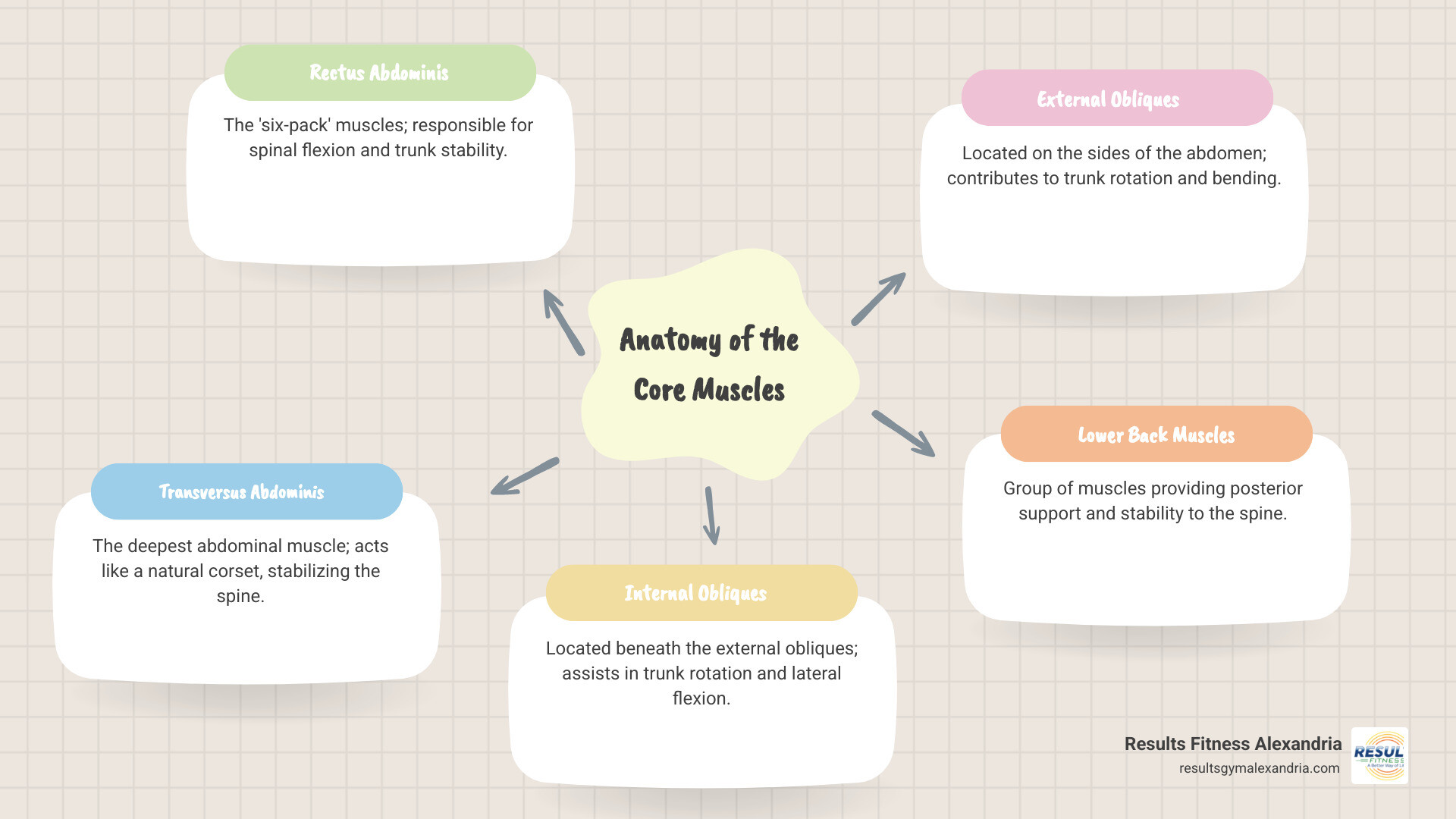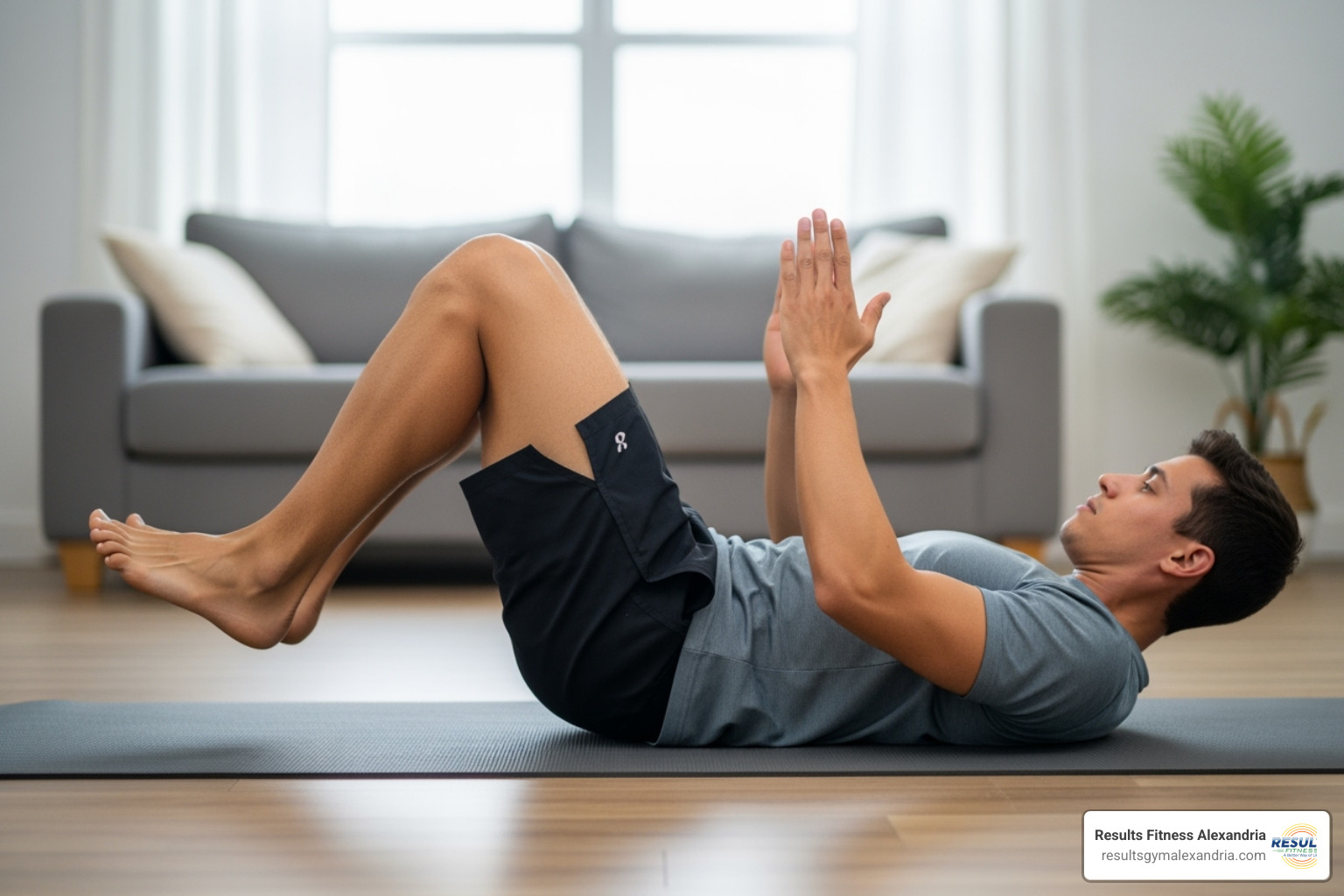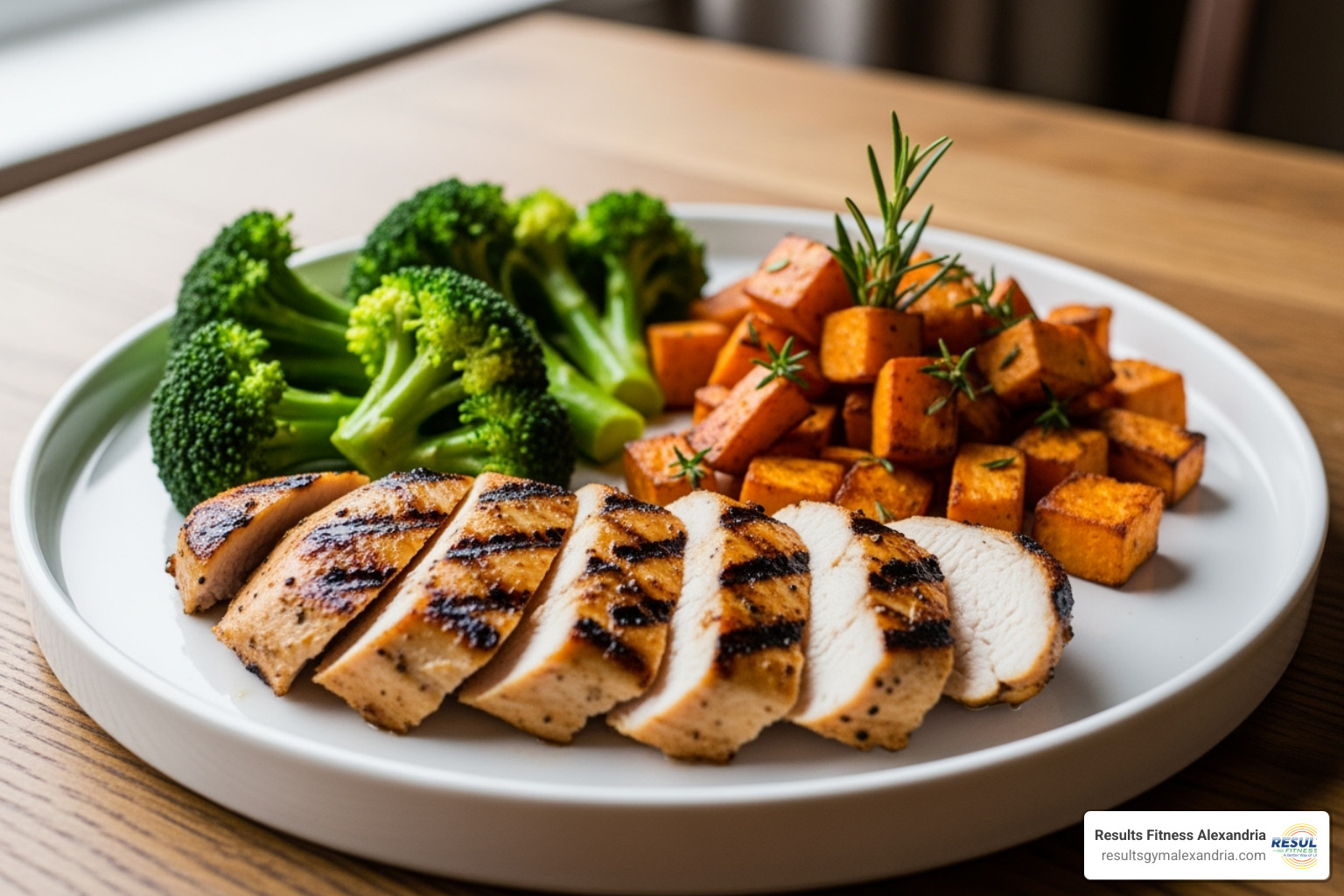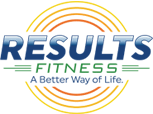Abs Class Workout: Unleash 15-Min Core Power
Why an Abs Class Workout is the Foundation of Total Body Strength
An abs class workout is more than a quest for a six-pack; it’s the key to building functional core strength that improves how you move, stand, and perform every day.
What You’ll Get from an Abs Class Workout:
- Core Stability & Better Balance
- Injury Prevention & Reduced Back Pain
- Improved Athletic Performance
- Functional Strength for Daily Life
- Community Support & Motivation
Your core is a complex system including the rectus abdominis (“six-pack”), transversus abdominis, obliques, and lower back muscles. Research confirms that core training improves posture and athletic power. Most people focus on looks, but the real benefit is building strength that supports everything you do.
I’m Jennifer Rapchak, Fitness Director at Results Fitness Alexandria. With over 14 years of experience as an ACE-certified trainer, I’ve seen how proper core training transforms not just bodies, but how confidently people move through their world.

Important abs class workout terms:
The Real Benefits of a Strong Core: More Than Just Aesthetics
While toned abs are a great goal, the true benefits of an abs class workout are functional. A strong core is the foundation for your entire body.

Better posture is an immediate benefit. Strong core muscles support your spine, helping you stand taller and reducing the slouching that can lead to neck and back pain. Research shows that core training positively affects posture.
Injury prevention is another key advantage. Your core acts as a natural brace for your spine during everyday movements, significantly reducing the risk of lower back pain.
Athletic performance also gets a major boost. Powerful movements originate from your center, and a strong core improves power transfer, coordination, and agility. This translates to better performance in sports and daily activities.
Finally, you’ll notice improved balance and stability, which is crucial for preventing falls and moving confidently. The benefits of group fitness classes help you build this functional strength in a supportive environment.
Key Core Muscle Groups Explained
An abs class workout targets your entire core, which includes:
- The rectus abdominis: The “six-pack” muscle at the front, responsible for flexing your spine. Research on selective muscle activation shows you can target its upper and lower portions.
- Your transversus abdominis: Your deepest core muscle, acting like a natural corset to stabilize your spine.
- The internal and external obliques: Located on your sides, these muscles allow you to twist and bend.
- Your lower back muscles: These work in partnership with your abs to support your posture.
A complete workout hits all these groups, creating a truly strong and stable midsection. You can learn more on our Fitness Blog.
Structuring the Perfect Abs Class Workout
An effective abs class workout isn’t about endless crunches; it’s about smart, structured training. Like other muscles, your abs need progressive overload—gradually increasing the challenge—to get stronger.
Every session should include a warm-up to activate your core and a cool-down with stretching to improve flexibility and prevent stiffness. This structured approach removes the guesswork from your routine. Find more tips on our Fitness Blog.
How Often Should You Train Your Abs?
More isn’t better. Your abs need recovery time to repair and grow stronger. Training your abs 2-3 times per week is ideal for most people, allowing for adequate recovery.
Your core also gets worked during compound exercises like squats and deadlifts, so listen to your body and rest when you’re sore. Quality sessions are more important than quantity.
What to Expect in an Abs Class Workout
Our abs class workout sessions are efficient and fun, typically lasting 15-30 minutes. We often use a HIIT format with timed intervals (e.g., 45 seconds of work, 15 seconds of rest) to maximize intensity and calorie burn.
The instructor guidance ensures you maintain proper form and get modifications when needed. Plus, the community motivation is a powerful tool—working alongside others helps you push harder than you would alone. Learn more in our Group Fitness Classes Ultimate Guide.
The Best Exercises for a Complete Core Workout
A complete core workout uses a variety of exercises to challenge your midsection from all angles. An effective abs class workout incorporates both bodyweight and weighted movements, drawing on principles of control and precision, similar to our Pilates classes.

Targeting Upper, Middle, and Lower Abs
While the rectus abdominis is one muscle, you can emphasize different areas:
- Upper abs: Target this area with movements that bring your chest toward your pelvis. Weighted crunches and V-ups are excellent for this.
- Middle abs: Focus on stabilization. The plank is the gold standard, while hollow holds build incredible stability.
- Lower abs: These are worked by bringing your pelvis toward your chest. Reverse crunches and leg raises are highly effective when performed with slow, controlled movements.
Hitting the Obliques and Serratus
For a complete, sculpted core, don’t neglect your sides:
- Side planks build lateral stability and can be modified with hip dips for a greater challenge.
- Russian twists, especially with a weight, are perfect for rotational strength.
- Bicycle crunches are a top-rated exercise by the American Council on Exercise for high oblique activation.
- Cable woodchoppers build real-world rotational power that engages your entire core.
Your At-Home Abs Class Workout Routine (15-Minutes)
No time for the gym? This 15-minute abs class workout hits all your core muscles. Warm up for 2-3 minutes, then perform the following circuit. Focus on quality over speed.
| Exercise | Duration/Reps | Rest | Focus |
|---|---|---|---|
| Bicycle Crunches | 60 seconds (controlled) | 15 seconds | Rectus Abdominis, Obliques |
| Plank | 60 seconds (hold) | 15 seconds | Entire Core, Stability |
| Reverse Crunches | 60 seconds (controlled) | 15 seconds | Lower Abs |
| Russian Twists | 60 seconds (per side) | 15 seconds | Obliques |
| Leg Raises | 60 seconds (controlled) | 15 seconds | Lower Abs |
| Side Plank (Left) | 30 seconds (hold) | 15 seconds | Obliques, Lateral Core |
| Side Plank (Right) | 30 seconds (hold) | 15 seconds | Obliques, Lateral Core |
| Weighted Crunches | 60 seconds (use water bottle) | 15 seconds | Upper Abs |
| Mountain Climbers | 60 seconds (dynamic) | Workout Ends | Core, Cardio |
This routine proves that short, focused workouts can deliver serious results.
Nutrition and Lifestyle: The Keys to Opening Up Your Abs
You can have the strongest core in the world, but abs are made in the kitchen. To see the definition you’re building in an abs class workout, you must address the layer of body fat covering the muscles.

This requires a calorie deficit, meaning you burn more calories than you consume. Focus on a diet rich in protein to build muscle, complex carbs for energy, and plenty of vegetables. Hydration is also key for metabolism and energy. Don’t neglect sleep and stress management, as both impact hormones that control fat storage, particularly around the midsection.
How Diet Reveals Your Hard Work
According to the ACE guide to body fat percentage, visible abs typically appear at 14-20% body fat for women and 6-13% for men.
Spot reduction is a myth; you can’t crunch away belly fat. Your body loses fat from all over, and the midsection is often the last place to lean out.
Genetics also influences where you store fat and the shape of your abs (e.g., a four-pack vs. a six-pack). Focus on consistent training and whole, nutrient-dense foods, and the results of your hard work will follow.
Common Mistakes to Avoid for Maximum Effectiveness
To get the most from your abs class workout and avoid injury, it’s crucial to avoid common mistakes. The biggest errors are rushing reps, overtraining, and using improper form. One perfect rep is better than ten sloppy ones, and your muscles need rest days to recover and grow.
Proper Form for Foundational Exercises
Planks: Avoid sagging or piking your hips. Your body should form a straight line from head to heels. Engage your glutes and core. If you can’t hold the form, drop to your knees.
Crunches: Stop yanking on your neck. Place fingertips lightly behind your head or cross your arms over your chest. Lead with your chest, not your chin, to make your abs do the work.
Leg raises: Prevent your lower back from arching off the floor. Actively press your lower back down throughout the movement. If this is difficult, bend your knees or place your hands under your glutes for support.
Finally, focus on the mind-muscle connection. Slow down and concentrate on feeling your abdominal muscles contract with each rep. This focus on quality will dramatically improve your results.
Frequently Asked Questions about Ab Workouts
Here are answers to common questions about any abs class workout.
Why do my ab exercises hurt my lower back?
This is often due to a weak core, tight hip flexors, or incorrect form. When your deep core muscles aren’t strong enough, your lower back tries to compensate, leading to strain. To fix this, focus on proper form and strengthen your entire core with exercises like bird-dogs and dead bugs, which build stability without stressing the spine. If you feel pain, stop and ask an instructor for a modification.
Can I get a six-pack just by doing an abs class workout?
An abs class workout builds the muscle, but nutrition reveals it. Visible abs depend on having a low body fat percentage (typically 6-13% for men, 14-20% for women). This requires a calorie deficit, consistent training (including cardio and strength), and patience. Genetics also determines the shape and appearance of your abs.
What’s better: bodyweight or weighted ab exercises?
Both are excellent. Bodyweight exercises are perfect for building a foundation of stability and endurance. Once you’ve mastered form, weighted exercises provide the progressive overload needed for muscle growth (hypertrophy). The best approach is to start with bodyweight movements and add weight as you get stronger. Our instructors can help you decide when to progress and how to choose the right fitness class for your goals and preferences.
Conclusion
Your abs class workout is a journey toward functional strength that transforms how you move. A strong core—including your rectus abdominis, transversus abdominis, obliques, and lower back—is the foundation for better posture, injury prevention, and improved athletic performance.
Consistency is your secret weapon. Focus on proper form, listen to your body, and remember that nutrition reveals your hard work. Combining smart training with healthy eating is the key to seeing results.
At Results Fitness Alexandria, we’ve seen countless members find their core strength and transform their fitness.
Ready to experience this for yourself? We invite you to explore our diverse Group Fitness classes and see what a dedicated abs class workout can do for you. Our expert instructors are here to guide you every step of the way. Your strongest, most confident self is waiting.
